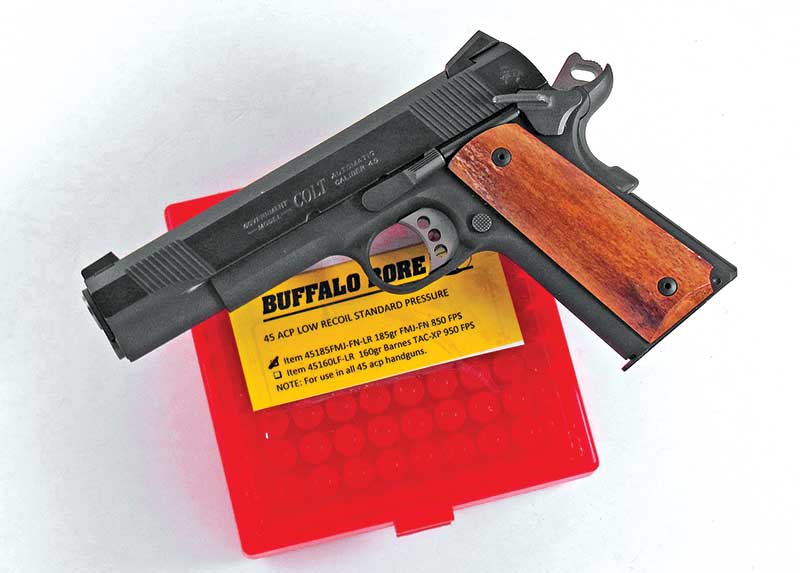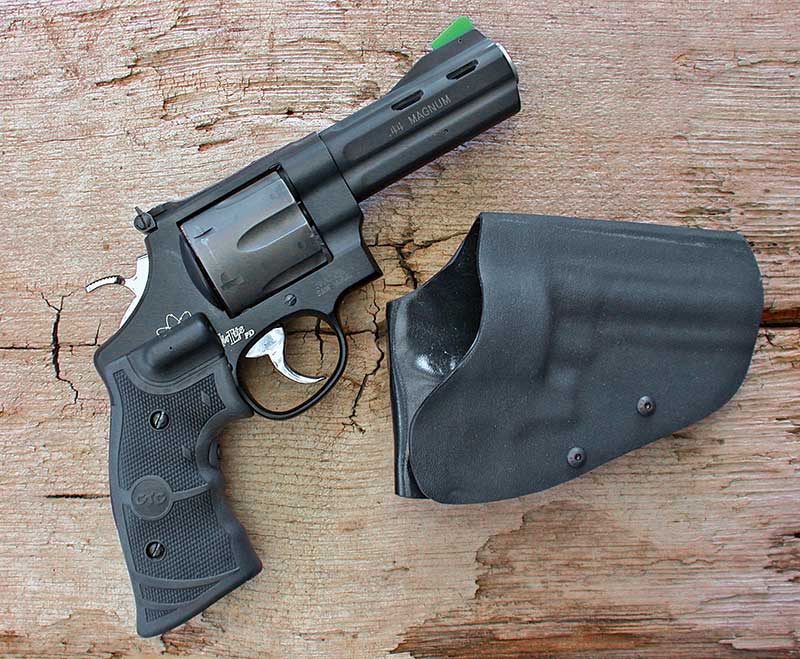Old Man Guns
Recently, an 87-year-old man worked his wheelchair into the local gun shop to show my friend Cactus behind the counter his new self-defense purchase. The old man had just come from one of the franchise stores in town and they sold him about the worst possible self-defense revolver an old fragile person could get. His new gun was a lightweight titanium/scandium/un-obtanium 2″.357 Magnum 5-shot revolver.
Now this wouldn’t be a terribly bad choice if it was matched up with the proper ammunition, which I see being nothing more than .38 Special target wadcutters. Although designed for cutting nice round holes in paper targets, their full frontal area also qualifies them for self-defense use — especially when matched up with low recoil.
However, the old man’s ammunition — which was sold to him by the same person who placed the exceptionally lightweight .357 Magnum in his hand — was a box of high dollar +P+ heavy-bulleted .357 Magnum loads. As Cactus told me, if the old boy had fired this combination he probably would’ve broken something in his hand.
Cactus then made sure the old man had ammunition that wouldn’t do as much damage at the backend as the front. Personally, I almost always recommend a properly loaded, quality double-action .38 Special — which is easily obtainable in new and used sixguns.
Age Brings Change
When we’re young, we can’t see ourselves getting old. We may wish for the day we’re of legal age, but it seems like something way, way, way off in the future. Then there comes a day when we realize our bodies are changing and it isn’t too long until we feel the effects of getting older.
I used to be able to shoot hundreds upon hundreds of heavy loads — really heavy sixguns loads. I’m now more careful; my wrists are banded and I’ve started wearing gloves. There was a time when the .44 Magnum was the least powerful big-bore cartridge I shot; now it’s at the top of the heap and I only shoot bigger stuff when absolutely necessary.
I also had to change my approach while shooting semi-autos. With the .45 ACP, recoil isn’t normally the problem — I find the grip frame of a standard 1911 to be very user-friendly. The problem is my fingers have a tendency to go numb, which makes it difficult to pick up small things. Sometimes I have difficulty working the slide on a semi-auto.
I watch the guys on the shooting shows work their slides and they seem to be on ball bearings. I often have to cock the hammer to release pressure before I can easily work the slide. So, I decided to make an Old Man 1911.
Semi-Auto Candidate
Shooters have many choices when it comes to 1911’s, such as a full-sized, all-steel Government Model or a shorter-barreled, lightweight Commander. I like them both and I shoot them both. Colt recently came out with a combination of the two with their 1911 Lightweight .45 ACP. This is a full-sized Government Model with a Commander-type alloy frame. To me, it’s the best of both worlds as we have the easy-to-pack weight of the Commander matched up with the full-sized sight radius of the Government Model. This would be my candidate for a semi-auto Old Man Gun.
I went to my local gunsmith, Tom at Buckhorn and his 1911 specialist Randy, and asked them to do some polishing
on the rails, so the slide would work a little easier and I wouldn’t have to cock the hammer first. Mainly, I wanted them to change the springs, so I asked them to pull the recoil spring and mainspring, putting them away if I ever want to go back to the original and start with two new ones — removing coils makes everything work easier. Once you start this process, you better know which ammunition you’re going to use to ensure it’s 100 percent reliable.
Since this is a lightweight 1911 and it’ll be an old man behind it, I certainly didn’t want to use +P or even standard loads. Earlier, I reported in this magazine on the Low Recoil Loads being offered by Buffalo Bore (Handloading, July/Aug 2013). The idea came from a reader whose Commander was more than he could handle as he had gotten older, so I passed this on to Buffalo Bore and they came up with an excellent solution. Buffalo Bore has a 185-gr. load with a muzzle velocity of standard 230-gr. loads. It still gives plenty of power for self-defense while at the same time reducing felt recoil.
I took a box of Buffalo Bore’s 185-gr. Low Recoil Loads to my gunsmiths and they began the work of lightening up the springs. When they finished they ran three full magazines through the 1911 — everything worked perfectly. The polishing of the rails added to the lightening of the springs, making it possible for me to easily work the slide without cocking the hammer first. For the intended use, this Colt Lightweight 1911 definitely falls into the category of Perfect Packin’ Pistol.
What About Sixguns?
How about big-bore sixguns as Old Man Guns? Cartridges such as .22, .32 and .38 Special are a given, but I wanted to stay with big bores and there’s no better big bore for this than the .44 Special. It does more with less recoil than any cartridge I know. The original loading was an approximately 250-gr. roundnose bullet at 750 fps. A better choice today for self-defense is the CCI 200-gr. JHP using the “flying ashtray” bullet. These are low recoil loads, especially in full-sized sixguns.
Smith & Wesson has been making N-frame .44’s since late 1907. Their first was the Triple-Lock, an absolutely beautiful sixgun, which can’t always be protected against gun butchers. A few years ago I picked up two Triple-Lock .44 Specials … and they were prime examples of butchery. So much so you’d really have to wonder what in the world their former owner was thinking.
To make it worse, one of the guns was the very rare Triple-Lock Target. Both guns had been cut to 4″ and had a poorly-shaped front sight fitted, they were then buffed and nickel-plated. The Target Model still had the original rear sight while the other had a channel cut for a new sight across the top of the frame, which was still bare.
I took these two guns, with apologies to my gunsmiths at Buckhorn, along with new sights. The front sights had blades while I had two rear sights. One was a D&L fixed sight, which filled in the channel in the standard Triple-Lock, and we went with a new-style Smith & Wesson adjustable rear sight for the Target Model. Both guns are now usable and shoot to point of aim and also qualify quite nicely as OMG’s (Old Man Guns) with the above-mentioned 200-gr. JHP load.
Not too long after putting these two .44 Specials back into shooting shape, I was on the Internet and found another S&W .44 Special which someone nearly destroyed. This was a very rare 1950 Military, a gun worth well over $1,000 in excellent shape. I got it for hardly anything simply because someone had bobbed the hammer, which was easily fixed by replacing it with a new hammer.
A very coarse file set about reshaping the grip frame and the original grips to a round-butt version. This wasn’t easily fixed, however the aforementioned Cactus not only came up with the replacement hammer, but also worked over a pair of custom grips to fit and cover up what had been done to the grip frame. Loaded up with the 200-gr. JHP’s once again makes this an excellent double-action OMG.
More Worthy Options
Another sixgun option, which is very popular in Alaska, doesn’t even come close to being an OMG when loaded with .44 Magnum rounds. This sixgun is the S&W ultra-lightweight Model 329PD, a sixgun Hamilton Bowen believes you’d have to be somewhat crazy to shoot with full-house loads. I shot it with them and I have to say I totally agree with him. However when loaded with 200-gr. JHP .44 Specials it’s very easy to shoot.
To make it even more so, I’ve equipped mine with Crimson Trace laser sight grips. This isn’t the way engineers at S&W intended it to be used, but I’ll call it an “Unintended Consequence,” which really turned out positively.
One final Old Man Gun choice is a sixgun going back 100 years or more. In the 1870’s and 1880’s, Smith & Wesson pioneered the big-bore top-break revolver. Before the outbreak of World War II, both S&W and Colt were offering swing-out, solid top-frame double-action revolvers. The British and Canadians adopted the new Smith & Wessons and Colts, but they also had the top-break Enfield and Webley revolvers.
I especially like the Webley and I found one at a very reasonable price, which had been converted from .455 to .45 ACP, using full moon clips. When unlatching, all cartridges automatically eject and it’s very easy to reload. Matched up with the same Low Recoil loads from Buffalo Bore, it’s a very easy shooting “modernized” old sixgun.









